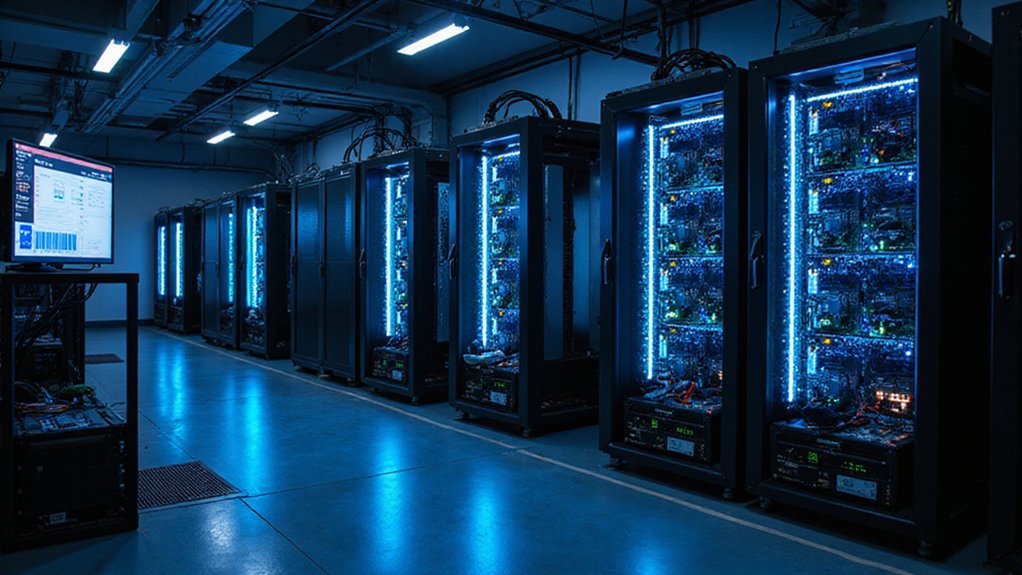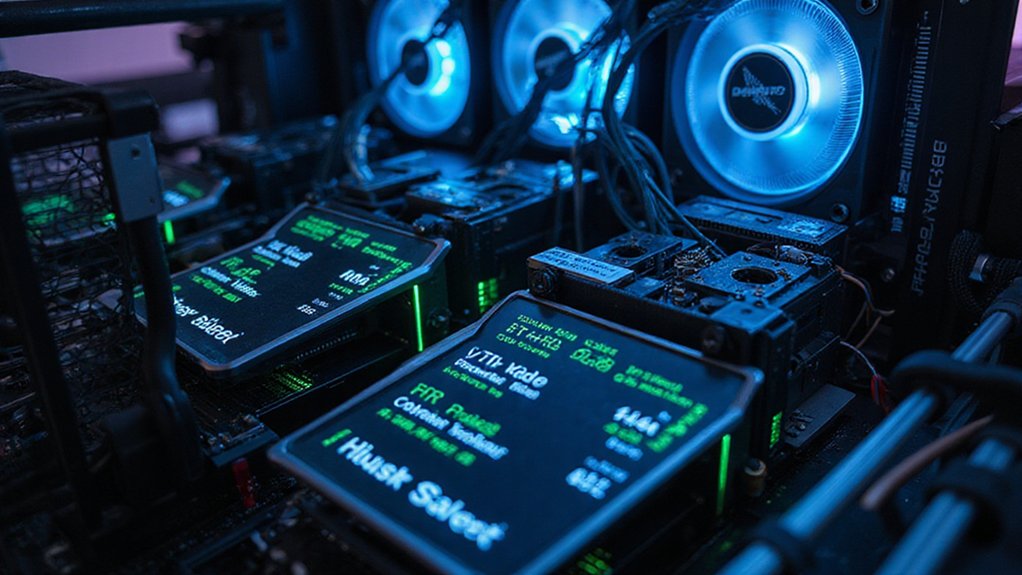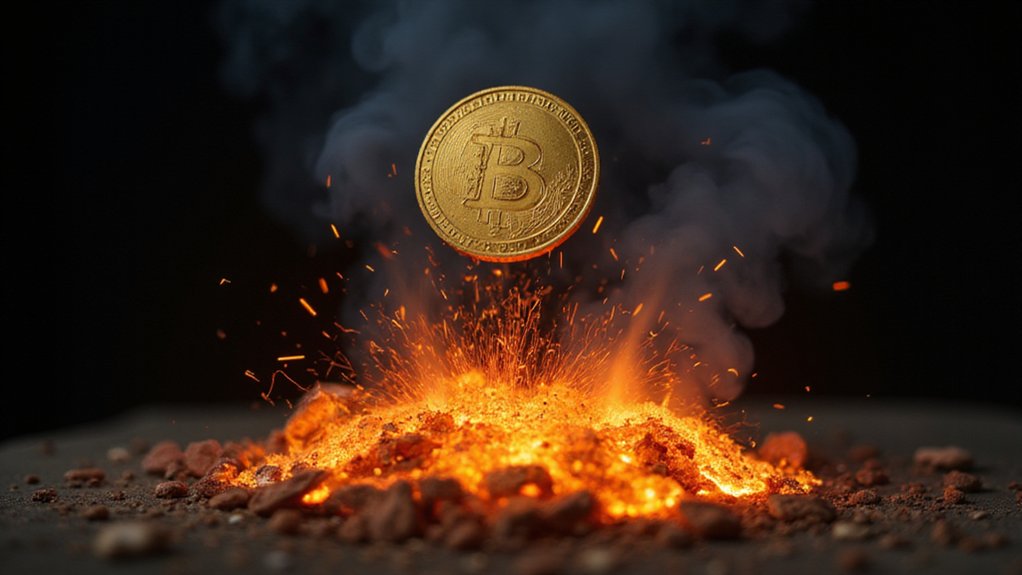Cryptocurrency mining—that curious digital gold rush of our era—involves powerful computers competing to solve complex mathematical puzzles that validate blockchain transactions. Miners deploy specialized hardware (typically ASICs) to generate cryptographic hashes below a target threshold, earning newly minted coins and transaction fees for their computational labors. This energy-intensive process simultaneously secures the network and introduces new currency into circulation, with profitability hinging on electricity costs and cryptocurrency values. The rabbit hole of mining economics and environmental implications runs surprisingly deep.

How exactly does one extract digital currency from the ether?
The process, less alchemical than it sounds, involves cryptocurrency mining—a computational endeavor where participants validate transactions and secure blockchain networks through the solving of complex mathematical puzzles.
These digital prospectors deploy considerable computational resources to compete in a technological race, with the victors earning newly minted cryptocurrency units and transaction fees as their reward.
At its core, mining entails the validation of pending transactions, their compilation into blocks, and the subsequent addition of these blocks to the blockchain—a distributed public ledger.
Miners employ cryptographic hash functions to generate a unique digital fingerprint for each block, linking it permanently to the chain.
This Proof-of-Work (PoW) system requires miners to find a hash value below a target threshold, a pursuit that necessitates vast computational trials and errors. Each successful miner must produce a 64-digit hexadecimal number that meets the network’s difficulty requirements.
The hardware requirements for this digital excavation are substantial.
Graphics Processing Units (GPUs) once dominated the mining landscape, but Application-Specific Integrated Circuits (ASICs)—devices engineered exclusively for mining particular cryptocurrencies—have since supplanted them in efficiency.
These machines, voracious consumers of electricity, often require elaborate cooling systems to maintain peak performance.
The associated operational costs represent a significant consideration for aspiring miners. The energy consumption of Bitcoin mining alone exceeds that of some entire countries, raising serious environmental sustainability concerns.
Mining difficulty fluctuates in response to network activity.
As more computational power joins the network, the target hash becomes more elusive, creating a self-regulating ecosystem where block times remain relatively consistent.
This competitive environment has spawned mining pools—collectives where participants combine resources to enhance their probability of securing rewards, which are subsequently distributed proportionally.
The cryptographic puzzles that miners solve ensure network security by making it computationally infeasible for malicious actors to perform double spending attacks on the blockchain.
The economics of mining are precarious.
Block rewards—currently the primary incentive for miners—undergo periodic “halving events” that reduce their magnitude, a mechanism designed to control cryptocurrency supply.
Coupled with the notorious volatility of cryptocurrency valuations and the substantial energy costs inherent to the operation, mining profitability remains in perpetual flux—a high-stakes technological gamble where fortune favors both the bold and the energy-efficient.
Frequently Asked Questions
How Much Electricity Does Cryptocurrency Mining Consume?
Cryptocurrency mining consumes staggering amounts of electricity—Bitcoin alone requires approximately 150 TWh annually, representing 0.6% of global electricity consumption and exceeding 160+ countries’ combined usage.
A single Bitcoin transaction’s energy footprint dwarfs hundreds of thousands of Visa transactions (an asymmetry that would make even the most ardent crypto enthusiasts wince).
Mining facilities in the U.S. utilize up to 10.3 GW collectively, with consumption projected to increase as mining difficulty rises until Bitcoin’s final coin is minted in 2140.
Can I Mine Cryptocurrency on My Smartphone?
While technically possible, mining cryptocurrency on a smartphone represents a curious intersection of theoretical capability and practical futility.
Smartphones lack the computational horsepower necessary for profitable mining operations—particularly for Bitcoin, where specialized ASICs have rendered other devices effectively obsolete.
The combination of hardware limitations, energy inefficiency, and cooling challenges guarantees that any mining attempt would likely generate more heat than profit, potentially damaging one’s device in pursuit of negligible returns.
Is Mining Cryptocurrency Legal in All Countries?
Cryptocurrency mining’s legal status varies dramatically across the global regulatory landscape.
While jurisdictions like Japan, Switzerland, and Germany embrace mining activities, others (notably China and Algeria) have implemented outright bans.
The regulatory environment continues evolving rapidly, with the EU’s MiCAR framework requiring licensing for crypto-asset services starting December 2024.
Meanwhile, at least a dozen U.S. states introduced mining-focused legislation in 2025 addressing energy consumption concerns.
Compliance requirements increasingly encompass energy reporting, AML scrutiny, and jurisdiction-specific licensing mandates.
How Long Does It Take to Mine One Bitcoin?
The time to mine one Bitcoin—a question that betrays a common misconception.
With the current 3.125 BTC block reward and 10-minute intervals, the answer depends entirely on one’s hash power relative to the network’s staggering 500+ EH/s.
For most miners, it’s a fractional endeavor; pool participants might accumulate 1 BTC over months or years, while solo miners (a quixotic pursuit these days) could theoretically wait decades unless blessed with extraordinary computational resources and improbable luck.
What Happens to Mining When All Bitcoins Are Mined?
When all bitcoins are mined (circa 2140), the mining paradigm shifts dramatically from block reward-driven to purely transaction fee-based economics.
Miners—those stalwart validators of the blockchain—will continue producing blocks every ten minutes, but their compensation will derive solely from users’ fee payments.
This shift necessitates either substantial transaction volumes or premium fees to maintain network security—a fascinating experiment in economic incentives that will determine whether Bitcoin’s decentralized security model remains viable without its inflationary subsidy.









